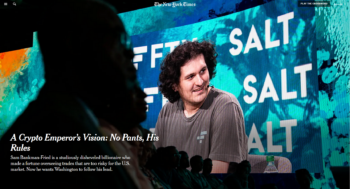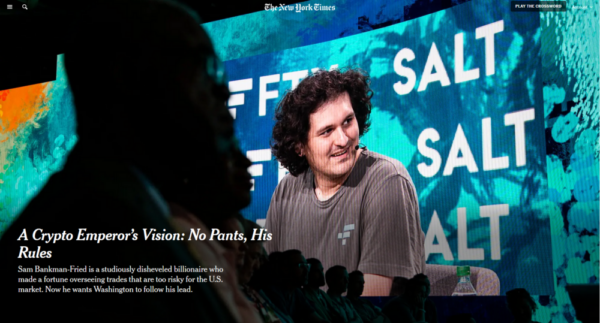While Crypto Bro Scammed Clients, Reporters Scammed Readers
ECONOMICS, 28 Nov 2022
Ari Paul | FAIR - TRANSCEND Media Service
Before Bankman-Fried’s transition from financial genius to possible financial criminal, he received little scrutiny in the media.
19 Nov 2022 – Today, you probably know who Sam Bankman-Fried and FTX are, and the details of why he and his company are front-page news are emerging at an amazing pace. Here’s the short version: Bankman-Fried—a boyish-looking cryptocurrency baron known commonly as SBF—announced that his lauded cryptocurrency exchange, FTX, had lost at least $1 billion in client funds, sending the crypto market into a tailspin (Fox Business, 11/16/22). The company, once the third-largest cryptocurrency exchange (AP, 11/16/22), has filed for bankruptcy. Lest one think this is a debacle that only affects crypto bros, Treasury Secretary Janet Yellen warns that “the sector’s links to the broader financial system could cause wider stability issues” (New York Times, 11/17/22).
How could this happen? How could no one have seen this coming? These are the questions many people are asking. One problem is that in the months leading up to Bankman-Fried’s transition from financial genius to possible financial criminal (Yahoo Finance, 11/14/22), he received little scrutiny in the media. On the contrary, he was celebrated.
‘Pragmatic style’

The New York Times (5/14/22) largely embraced Sam Bankman-Fried’s self-presentation as “a straight-talking brainiac willing to embrace regulation of his nascent industry and criticize its worst excesses.”
Among the silliest suck-ups came from the New York Times (5/14/22), in which David Yaffe-Bellany, the paper’s cryptocurrency correspondent, said that Bankman-Fried’s “pragmatic style” came from his parents, who “studied utilitarianism, an ethical framework that calls for decisions calculated to secure the greatest happiness for the greatest number of people.” Yaffe-Bellany added that “Bankman-Fried is also an admirer of Peter Singer, the Princeton University philosopher widely considered the intellectual father of ‘effective altruism.’” (Singer has been criticized for his eugenics-like approach to disability—FAIR.org, 1/20/21.)
Yaffe-Bellany was also widely lambasted for providing media cover for Bankman-Fried even after his empire collapsed (New York Times, 11/14/22). As Gizmodo (11/15/22) put it:
The new article in the New York Times by David Yaffe-Bellany lays out the facts in ways that are clearly beneficial to SBF’s version of the story and leaves many of his highly questionable assertions without proper context or even the most minimal amount of pushback. The result isn’t to illuminate the shadowy world of crypto. It reads like…the Times had conducted an interview with Bernie Madoff after his Ponzi scheme collapsed and ultimately suggested he just made some bad investments.

Bloomberg (4/3/22) called Bankman-Fried “a kind of crypto Robin Hood, beating the rich at their own game to win money for capitalism’s losers.”
The conservative New York Post (11/15/22) used Yaffe-Bellany’s reporting to tweak the establishment Times for its coziness with someone who may face criminal indictment. But the Post‘s sibling paper, the Wall Street Journal (10/30/22), had just weeks earlier given Bankman-Fried free, uncritical space to pump out optimism about cryptocurrencies, including the idea that value drops in crypto were just part of a general economic fluctuation: “It wasn’t just crypto…. By and large what we saw this year was a broad-based risk-asset selloff, as this monetary inflation reared its head, became noticeable enough to inspire policy change.”
Bloomberg (4/3/22) likewise had painted Bankman-Fried as an eccentric financial whiz kid, whimsically frugal with a “Robin Hood–like philosophy,” while Reuters (7/6/22) ran with his claims that not only did he have “a ‘few billion’ on hand,” but that he would graciously use it to “shore up struggling firms.” An accompanying photo of Bankman-Fried with a T-shirt and disheveled hair made him look like the reincarnation of Abbie Hoffman.
Barron’s reran an AFP story (2/12/22) that, again, highlighted Bankman-Fried’s “spartan lifestyle,” his vegan diet and his casual wardrobe. Matthew Yglesias (Slow Boring, 5/23/22), an economics commentator and a graduate of Slate and Vox, wrote, “I think [his] ideas, as I understand them, are pretty good.” None of these pieces really probed whether his business was sustainable.
Shadowy sector
How on Earth did this T-shirt-clad man charm American media into thinking that he could manage billions of dollars in wealth, based on an intangible commodity that has no intrinsic value? Analysts have long tried to get the media class to understand that crypto has many inherent problems (Jacobin, 12/26/17, 10/17/21), that the crypto market’s value has tanked (CNBC, 6/15/22), that Bitcoin wealth is highly concentrated (Time, 10/25/21) and that Bitcoin, despite being Internet-based, is highly environmentally destructive (Guardian, 9/29/22).
One might think—or hope—that, after Enron, WorldCom, Bernie Madoff, Jordan Belfort and the 2008 financial crisis, that the business press could harbor skepticism about financial and business leaders in general, but particularly those in a shadowy, emerging sector known for its instability (Forbes, 5/10/22) and its susceptibility to scams (Forbes, 9/23/22).
Bankman-Fried, unfortunately, was a dangerous combination of factors that could win over reporters. He was optimistic about a troubled financial sector. He was making billions while spouting altruistic ideas and remaining personally thrifty, a kind of mysterious being who could be presented as a poster child for a more ethical version of capitalism. His insistence on casual dress suggested that he was just so smart, his brain operated above the mundane details of regular business.
His image was simply fun to write about. And this all made for the kind of good copy—and photographs—that will make an editor happy at deadline time. But this allowed his image to be the main focus for the press, rather than the goings-on of his business.
Doug Henwood, host of KPFA’s Behind the News and the author of Wall Street: How It Works and for Whom, told FAIR:
The business press is rarely skeptical about the speculative heroes of the moment. There are exceptions; if you read carefully, you can get a good critique. But the general culture is boosterish. Just a few months ago, SBF was a genius. Elon Musk, too, though his antics at Twitter are making that cult harder to sustain. Before that it was Elizabeth Holmes and her magical blood-testing machine. Go back a couple of decades and it was Ken Lay and Enron (celebrated by none other than [New York Times columnist] Paul Krugman, who’d also been paid a consulting fee by the company).
There are a lot of reasons for this. Many business journalists identify with the titans they cover—some even aspire to join them, as did former New York Times reporter Steven Rattner, who became an investment banker. Then there’s the fear of alienating your sources—the dreaded loss of “access.” And then there’s the general reluctance to be the skunk at the picnic—when markets are frothing, it’s more fun to play along than play the critic.

NBC (11/16/22): Bankman-Fried “is hardly the first wealthy donor, and certainly won’t be the last, whose ideological agenda is difficult to disengage from business motives.”
As NBC (11/16/22) noted, Bankman-Fried’s wide spending bought him wide influence, as he
visited the White House, attended a congressional retreat, and held countless meetings with lawmakers and top regulators. He got chummy with Bill Clinton after paying the former president to speak at a conference. He spent $12 million getting a referendum on the ballot in California. And he earned praise during Senate testimony from Sen. Cory Booker, D-N.J., for a “much more glorious afro than I once had.”
In just two years since Bankman-Fried’s first political donation, his money hired dozens of top-flight lobbyists and political operatives, made major investments in newsrooms like ProPublica and Semafor, and made him the second-biggest Democratic donor of the 2022 midterms, behind only the 92-year-old financier George Soros. He said $1 billion would be a “soft ceiling” for his spending in 2024.
The whole mess is sparking a conversation about whether cryptocurrency markets demand tighter and more robust regulation (Fortune, 11/14/22; Washington Post, 11/17/22). But there needs to be a discussion about the media’s role in this as well. Reporters should be skeptical of crypto market actors, for all the reasons stated above, but they also should be skeptical of business leaders more generally.
Good public relations is as important to a business’s bottom line as the strength of its product. Reporters and editors need to fight the urge to be a part of that.
_________________________________________
 Ari Paul has reported for the Nation, the Guardian, the Forward, the Brooklyn Rail, Vice News, In These Times, Jacobin and many other outlets.
Ari Paul has reported for the Nation, the Guardian, the Forward, the Brooklyn Rail, Vice News, In These Times, Jacobin and many other outlets.
Tags: Capitalism, Conspiracy Theories, Corporate Media, Corruption, Cryptocurrency, Economics, FTX, Finance, Mainstream Media MSM, Media, Money laundering, War Journalism, World Economic Forum
DISCLAIMER: The statements, views and opinions expressed in pieces republished here are solely those of the authors and do not necessarily represent those of TMS. In accordance with title 17 U.S.C. section 107, this material is distributed without profit to those who have expressed a prior interest in receiving the included information for research and educational purposes. TMS has no affiliation whatsoever with the originator of this article nor is TMS endorsed or sponsored by the originator. “GO TO ORIGINAL” links are provided as a convenience to our readers and allow for verification of authenticity. However, as originating pages are often updated by their originating host sites, the versions posted may not match the versions our readers view when clicking the “GO TO ORIGINAL” links. This site contains copyrighted material the use of which has not always been specifically authorized by the copyright owner. We are making such material available in our efforts to advance understanding of environmental, political, human rights, economic, democracy, scientific, and social justice issues, etc. We believe this constitutes a ‘fair use’ of any such copyrighted material as provided for in section 107 of the US Copyright Law. In accordance with Title 17 U.S.C. Section 107, the material on this site is distributed without profit to those who have expressed a prior interest in receiving the included information for research and educational purposes. For more information go to: http://www.law.cornell.edu/uscode/17/107.shtml. If you wish to use copyrighted material from this site for purposes of your own that go beyond ‘fair use’, you must obtain permission from the copyright owner.
